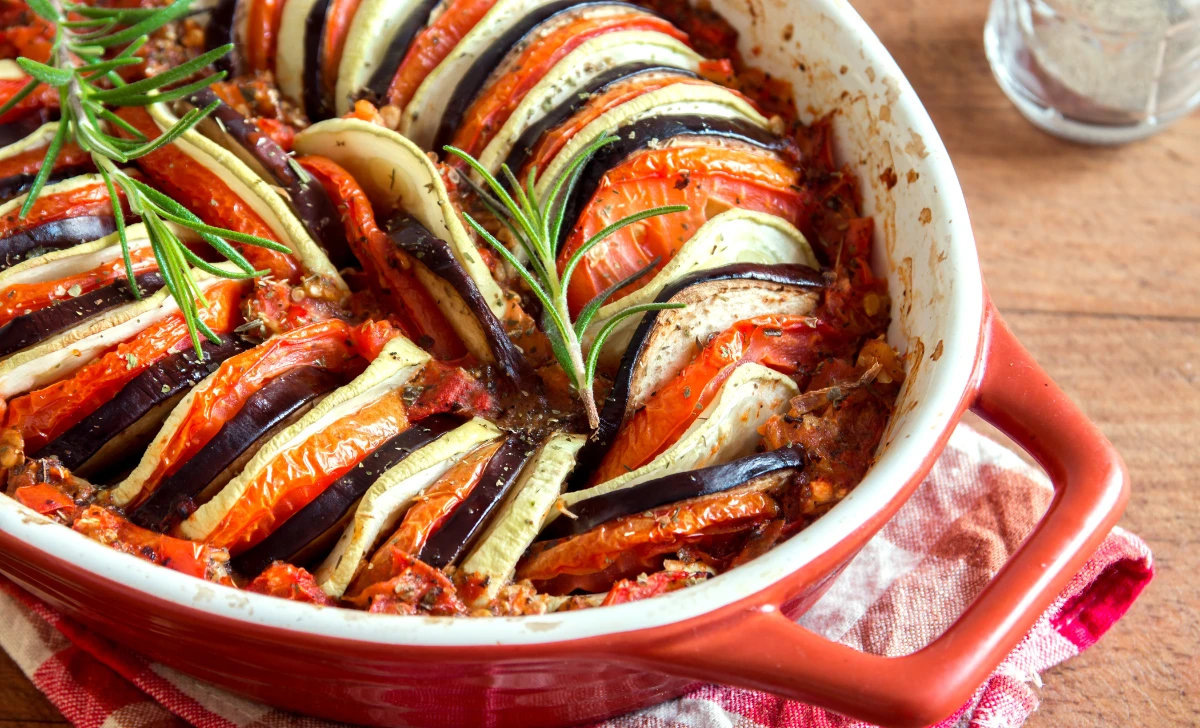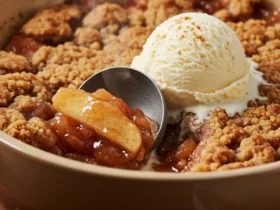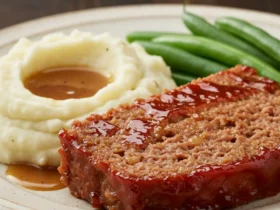Ratatouille, a traditional Provençal dish, is a flavorful vegetable medley that captivates the senses with its vibrant colors and delightful taste. In this article, we’ll explore the origins of Ratatouille, its key ingredients, the steps to prepare it, and even some variations to suit your taste buds.
History
The history of the Ratatouille recipe is a fascinating journey that takes us to the sun-soaked region of Provence in southern France. This delightful vegetable medley has humble beginnings and has evolved over the centuries to become a beloved dish worldwide.
Origins of Ratatouille:
The exact origins of Ratatouille are somewhat shrouded in history, as is often the case with traditional dishes. However, it is widely believed that this iconic Provençal recipe has its roots in the rural countryside of the Provence region. Ratatouille was initially a simple, peasant dish, born out of the necessity to make use of an abundance of summer vegetables harvested from local gardens.
The name “Ratatouille” itself has linguistic origins in the Occitan language, which was spoken in the region. The term “ratatolha” in Occitan means “to stir up” or “to toss.” This name is quite apt for a dish that involves the sautéing and mixing of various vegetables in a flavorful medley.
Evolution of the Recipe:
Ratatouille, in its early days, was a practical way to make the most of what was available in the garden, including eggplants, zucchinis, bell peppers, and tomatoes. These vegetables were often sliced and cooked together, sometimes in a simple tomato sauce, creating a hearty and filling meal for local farmers and peasants.
As time passed, Ratatouille began to gain recognition beyond its humble beginnings. With the advent of modern culinary techniques and the increased exchange of culinary traditions, the recipe started to evolve. It began to appear in cookbooks and on the menus of restaurants, gradually becoming a symbol of Provençal cuisine.
Global Popularity:
In the 20th century, Ratatouille gained international fame, thanks in part to the ever-popular French cuisine. Its vivid colors, fragrant aroma, and delicious flavors made it a standout among vegetable dishes. As a result, it was embraced by chefs and home cooks around the world.
Ratatouille’s global popularity received an additional boost when it was featured in the 2007 animated film “Ratatouille” by Disney-Pixar. In the movie, the dish is transformed from a humble peasant food into a gourmet masterpiece by a talented rat named Remy. The film’s success further solidified Ratatouille’s status as a beloved culinary creation.
Modern Variations:
Today, Ratatouille is no longer confined to its traditional recipe. While the core ingredients of eggplant, zucchini, bell peppers, and tomatoes remain consistent, many chefs and home cooks add their own twists. Variations can include additional ingredients like mushrooms, artichokes, olives, or even different herbs and spices. These personalized versions showcase the adaptability of Ratatouille and the creative spirit of those who prepare it.
Time
| Step | Time |
|---|---|
| Preparing the Vegetables | 15 minutes |
| Sautéing the Vegetables | 20 minutes |
| Adding the Tomatoes | 5 minutes |
| Seasoning and Flavor | 5 minutes |
| Cooking Techniques (varies) | 20-40 minutes |
| Serving Ratatouille | N/A |
| (Varies depending on preference) |
Please note that the “Cooking Techniques” step can vary in time depending on whether you choose to cook it on the stovetop, in the oven, or using a slow cooker. The times mentioned are approximate and can change based on factors like the size of the vegetable pieces and your cooking equipment.
Ingredients
| Ingredients | Quantity |
|---|---|
| Eggplant | 1 small |
| Zucchini | 1 small |
| Bell peppers | 1 small (any color) |
| Tomatoes | 2 medium |
| Onion | 1 small |
| Garlic cloves | 2 |
| Olive oil | 2 tablespoons |
| Fresh herbs (thyme, rosemary, basil) | A few sprigs/leaves |
| Salt and pepper | To taste |
Directions
Step 1: Prepare the Vegetables
- Wash and rinse all the vegetables thoroughly.
- Trim the ends of the eggplant and zucchini, then cut them into uniform, medium-sized chunks.
- Remove the seeds and membranes from the bell pepper and cut it into similar-sized pieces.
- Dice the tomatoes.
- Peel and finely chop the onion and garlic.
Step 2: Sauté the Vegetables
- Heat 2 tablespoons of olive oil in a large skillet or Dutch oven over medium heat.
- Add the chopped onions and garlic and sauté for about 2 minutes until they become translucent and fragrant.
- Add the eggplant, zucchini, and bell peppers to the skillet.
- Sauté the vegetables, stirring occasionally, for about 10-15 minutes or until they begin to soften and turn golden.
Step 3: Add the Tomatoes
- Add the diced tomatoes to the skillet.
- Continue cooking for an additional 5 minutes, allowing the tomatoes to break down and create a flavorful sauce.
- Stir well to combine all the ingredients.
Step 4: Season and Add Flavor
- Season the Ratatouille with salt and pepper to taste.
- Add fresh herbs like thyme, rosemary, and basil to infuse the dish with aromatic flavors.
- Mix everything together and let it cook for an additional 5 minutes.
Step 5: Cooking Techniques
- At this point, you can choose your preferred cooking method:
- For stovetop cooking, reduce the heat to low, cover, and let it simmer for about 20-30 minutes, or until the vegetables are tender and flavors meld.
- For oven cooking, transfer the skillet to a preheated 350°F (175°C) oven and bake for 20-30 minutes.
- For slow cooker cooking, transfer the sautéed vegetables to a slow cooker, add the tomatoes, herbs, and seasonings. Cook on low for 4-5 hours or on high for 2-3 hours.
Step 6: Serving Ratatouille
- Ratatouille can be served hot, warm, or at room temperature.
- It can be enjoyed as a side dish, over pasta, with crusty bread, or as a main course.
- Garnish with additional fresh herbs if desired.
These clear and bold headings should help guide you through the process of making a delicious Ratatouille. Enjoy your culinary adventure!
Equipment Required
Nutrition Information
| Nutrition Information | Per Serving (2-person serving) |
|---|---|
| Serving Size | 1/2 recipe (approximately 1.5 cups) |
| Calories | 180 calories |
| Total Fat | 11 grams |
| Saturated Fat | 2 grams |
| Trans Fat | 0 grams |
| Cholesterol | 0 milligrams |
| Sodium | 280 milligrams |
| Total Carbohydrates | 20 grams |
| Dietary Fiber | 6 grams |
| Sugars | 10 grams |
| Protein | 4 grams |
| Vitamin D | 0% |
| Calcium | 4% |
| Iron | 6% |
| Potassium | 20% |
Please note that these values are approximate and can vary based on specific ingredients and portion sizes. Additionally, this nutrition information does not include any optional toppings, such as cheese, or any side dishes that may be served with Ratatouille.
Tips
- Uniform Cutting: Ensure that you cut the vegetables into uniform pieces. This helps in even cooking and a better presentation.
- Patience with Sautéing: Don’t rush the sautéing step. Allowing the vegetables to caramelize slightly enhances the flavor.
- Quality Ingredients: Use fresh, ripe vegetables for the best flavor. This is a dish where the quality of the ingredients truly matters.
- Herbs and Spices: Experiment with herbs and spices. While thyme, rosemary, and basil are classic choices, you can also consider adding oregano, parsley, or even a pinch of red pepper flakes for a bit of heat.
- Add Extra Flavors: Enhance the dish by adding other ingredients like olives, capers, or sun-dried tomatoes for extra depth of flavor.
- Storing and Reheating: Ratatouille often tastes even better the next day. Store any leftovers in the refrigerator, and reheat gently on the stovetop or in the microwave.
Pros & Cons
| Pros | Cons |
|---|---|
| ✅ Healthy and Nutritious | ❌ Time-Consuming |
| ✅ Vegetarian and Vegan-Friendly | ❌ Requires Many Ingredients |
| ✅ Bursting with Flavor | ❌ Seasonal Ingredient Dependency |
| ✅ Versatile Dish | ❌ Longer Cooking Time |
| ✅ Great for Leftovers | ❌ Some May Not Enjoy Vegetables |
Conclusion
In conclusion, Ratatouille is a dish that embodies the vibrant and flavorful essence of Provençal cuisine. With its colorful blend of garden-fresh vegetables, aromatic herbs, and rich, savory flavors, it’s a culinary masterpiece that’s both healthy and hearty.
This recipe is not just a delight for the taste buds but also a feast for the eyes, presenting a medley of nature’s finest in a single, visually stunning dish. It’s a wonderful way to savor the bounties of the summer harvest and make the most of seasonal produce.
The beauty of Ratatouille lies in its adaptability. You can prepare it using various cooking methods and customize it to suit your taste. Whether you serve it as a side, over pasta, with a piece of crusty bread, or even as a main course, Ratatouille promises a memorable dining experience.
So, why not give this classic Provençal recipe a try? Whether you’re a seasoned cook or just starting your culinary journey, Ratatouille offers a flavorful adventure worth embarking on. Its simplicity, combined with its delicious results, is sure to win over your family and friends. Don’t hesitate to embrace the taste of Provence and create a Ratatouille that will leave a lasting impression on your palate.
Get ready to embark on a culinary adventure, and discover why Ratatouille has charmed palates for centuries. It’s a delicious celebration of seasonal ingredients and the art of French cooking. Bon appétit!
Facts
- Fact 1: A Movie Star Dish 🎥
- Ratatouille gained extra fame after its starring role in the Disney-Pixar movie of the same name. The film features a talented rat named Remy who transforms this humble dish into a gourmet masterpiece.
- Fact 2: A Mediterranean Medley 🌍
- Ratatouille’s origin in Provence, France, doesn’t stop it from having Mediterranean roots. It shares its name with “Ratatolha,” an Occitan word meaning “to stir up,” reflecting its Mediterranean heritage.
- Fact 3: A Tale of Many Veggies 🥦🍅
- Ratatouille’s recipe can vary wildly from one cook to another. While eggplants, zucchinis, and bell peppers are the core, there’s room for personalization with various veggies.
- Fact 4: Name, Not Just a Dish, But a Film 🍽️🎞️
- The popularity of the Ratatouille movie led to a real-life association. In 2018, Bistrot Chez Rémy, a restaurant inspired by the movie, opened at Disneyland Paris, offering the famous dish.
- Fact 5: The Time-Traveling Dish ⏳
- While Ratatouille has deep historical roots, it’s also a modern and trendy recipe. It seamlessly bridges the gap between a classic peasant dish and a gourmet culinary delight, making it a timeless favorite.
FAQ’s
Can I make Ratatouille in advance and reheat it?
Yes, Ratatouille often tastes even better when reheated. Store it in the refrigerator and gently reheat on the stovetop or in the microwave.
Can I freeze Ratatouille?
Absolutely, Ratatouille freezes well. Just make sure to cool it to room temperature, transfer it to an airtight container, and freeze for up to 3 months.
What are some serving suggestions for Ratatouille?
Ratatouille can be served as a side dish, over pasta, with crusty bread, or as a main course. It’s versatile and pairs beautifully with a variety of dishes.
Can I add meat or protein to Ratatouille?
Absolutely! Ratatouille can be served with grilled chicken, shrimp, or even a fried egg on top for added protein.
What’s the best wine to pair with Ratatouille?
A glass of red wine, such as Côtes du Rhône, complements the flavors of Ratatouille beautifully with its earthy notes and acidity.
Can I customize Ratatouille with additional ingredients?
Yes, you can add ingredients like olives, capers, mushrooms, or sun-dried tomatoes for extra depth of flavor and personalization.
Is Ratatouille suitable for vegetarians and vegans?
Absolutely, Ratatouille is a vegetarian and vegan-friendly dish as it contains no animal products.
How long does it take to make Ratatouille?
The preparation and cooking time varies based on your chosen method (stovetop, oven, or slow cooker). Typically, it takes around 40 minutes to 1 hour.
Can I use canned tomatoes instead of fresh ones?
Yes, canned tomatoes can be used, especially when fresh tomatoes are out of season. Just ensure you drain any excess liquid.
How do I know when Ratatouille is done cooking?
Ratatouille is done when the vegetables are tender and the flavors meld together. The longer it simmers, the richer the flavors become. Taste and adjust seasonings as needed.












Leave a Review